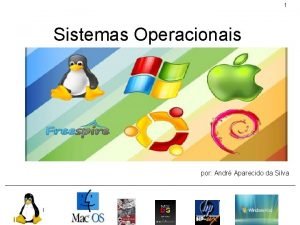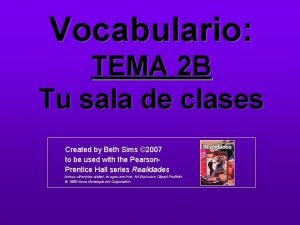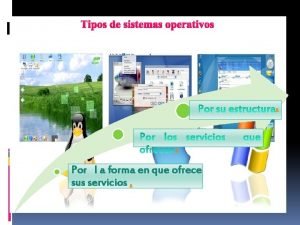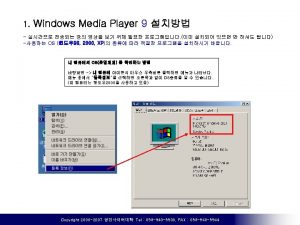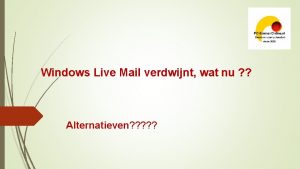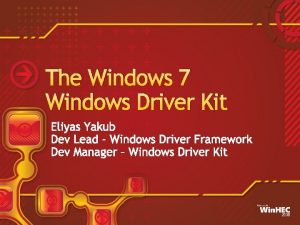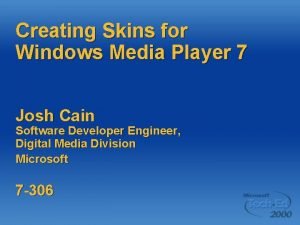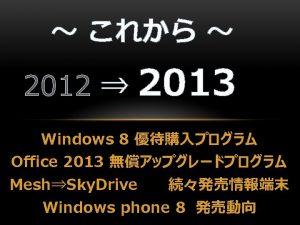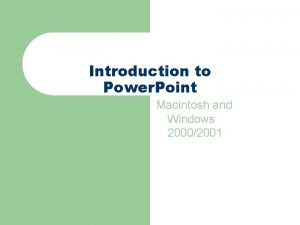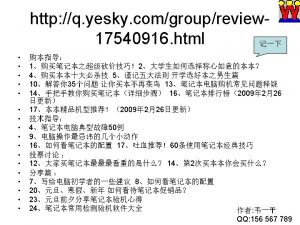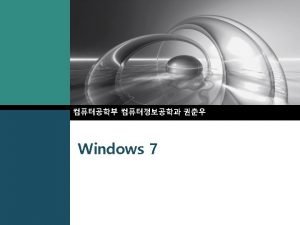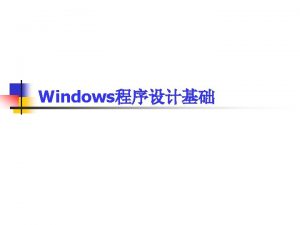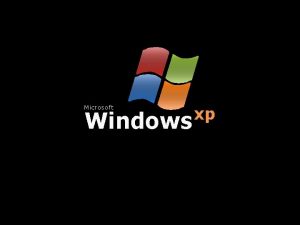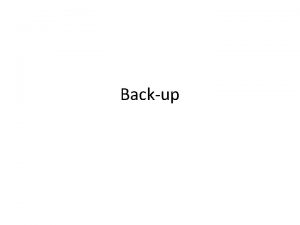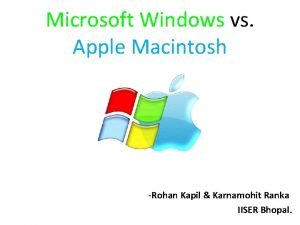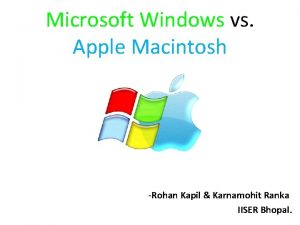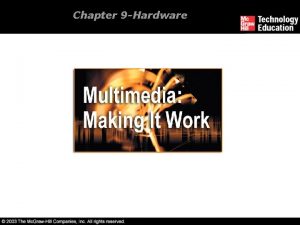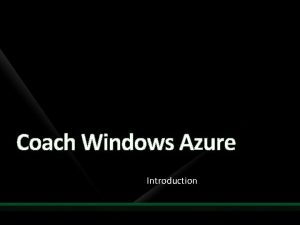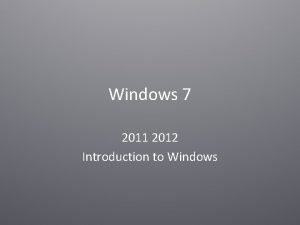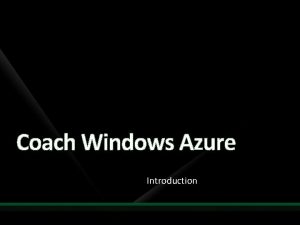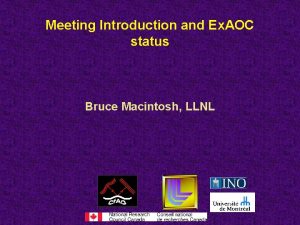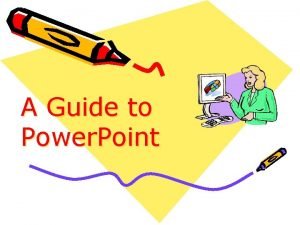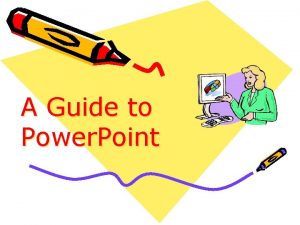Introduction to Power Point Macintosh and Windows 20002001






























- Slides: 30

Introduction to Power. Point Macintosh and Windows 2000/2001

Practice: Getting Started l l l Open Microsoft Power. Point. Choose “Template” from opening dialog box. You will see a series of menu tabs.

File > New > General Practice: Select a Template l. To use a template, click on the tab labeled. “Presentation Designs” and choose a template. l. To choose a blank presentation, click on “Blank Presentation” under the “General” tab.

Slide Layout Choose Your Slide Type: Bullet List 2 Columns Of Lists With or Without Chart With or Without Picture or other variations Choose a slide layout from the “New Slide” dialog box Title Slide Selected

Slide View l l l Lower left buttons. Highlight words and then delete or cut and paste. Use right scroll bar to move from slide to slide. You can change font size, style, and type just like you would in Microsoft Word. You can insert clip art or graphics that you have scanned. You can also insert sounds, movies, and animation.

Practice: Adding Content l Add points to each of your slides by clicking in the text area and typing. – l To Add text, choose Insert > Text Box, draw the box boundaries, and begin typing. When you hit return on a list slide, a new bullet will appear. – Use the tab key if you want to create a subentry like this one. Use This Button to add Clip Art Use This Button to quickly add a text box.

Editing Style and Color l l l Choose Format > Background to change background color and shading. Click the down arrow on drop-down list box for color and fill effects options. Click on “Fill Effects” to customize the background with lighting, textures, and patterns. The “Preview” button allows you to try out your changes before you commit to them. Format > Slide Color Scheme to change text, accent, and line colors and to create shadows.

Format > Background. . . Format Background Click on the drop-down menu and see the set of colors suggested for your scheme Choose “More Colors” for more solids or “Fill Effects” for patterns

Practice: Background l l Go to Format > Background. Click on the down arrow on the drop-down list box to choose a new color. Clicking on “Apply” modifies a particular slide; “Apply to all” modifies the entire presentation. Note: Some templates use background graphics. If you can’t see changes, click on “Omit background graphics from master. ”

Format > Slide Color Scheme Format Color Scheme Click on the “Custom” tag to select alternate colors for standard features. You can apply these selections to All of your slides or just the active one.

Practice: Color Scheme l l l Click on Format > Slide Color Scheme. Click on the “Custom” tab to alter colors for individual elements; choose the “Standard” tab to select pre-defined schemes. Double-click on the colored square labeled “Text and lines. ” Choose a new color. Click on “Preview”; then click on “Apply” to accept.

Inserting Objects l l Use Insert > Picture for a graphic. Choose Insert > Picture > Clip Art. Choose Insert > Object for other MS objects. For scanned images, select “Adobe Photoshop Image” from the dialog under Insert > Object.

Insert > Picture Insert Picture Use Clip Art to select from a database of images Or insert Movies, Charts, Tables, or Objects Use “From File” to select your own saved image files

Practice: Insert Clip Art l l l Go to any slide. Go to Insert > Picture > Clip Art. Use the category list to browse kinds of clip art. Click on a picture you would like to include. Click on “Insert. ”

Manipulating Objects l l l To move, click in the center of the object to select, hold and move. To resize, click on one of the handles and resize. To delete, click to select and hit the delete key.

Practice: Manipulating Objects l l Resize or scale the object on your title page. Move the object to the place on the page you want it to be. Your image must show the white squares in order to move or resize. Click on the center of the image to make these appear. To keep the proportions of the shape, only resize by clicking and dragging the corner markers.

Layering Objects l l To control the layering of objects, choose Draw (lower left button) > Order > Send to Back or Send to Front. To rotate, choose Draw > Rotate or Flip. Tip: Right click (or Control click on MAC) to see the order menu

Practice: Objects l l Take a few minutes to arrange or delete the object we have been experimenting with. If you have time, insert appropriate clip art elsewhere in your presentation.

Slide Sorter View l l Tiny-squares button on lower left. View mini-icons of slides. Easily view and create transitions and animations. Another way to reorder and insert slides. View All Slides in Slide Sorter View

Slide Show > Slide Transitions l l Transitions are effects for moving from slide to slide You can choose different transitions for each slide, “Apply to All” the same transition effect, or choose “random” to vary effects. You can also control the speed of the transition – choose slow to “Fade” into each slide Choose “Automatically After” to automate your slide show; each slide appears for X seconds.

Practice: Transitions l l l Click on the “Slide Sorter View” button. Double-click the slide to which you want to assign a transition. This will return you to Slide View. Choose Slide Show > Slide Transitions, and select a transition.

Slide Show > Custom Animations l. Animations change how objects, text boxes, and pictures appear in your slide. l. You can choose a “Preset Animation” or design a “Custom Animation” from the “Slide Show” menu.

Custom Animation: Timing Check the boxes next to the objects you want to animate. They appear below in the Animation Order box – you can change the order using the arrows to the right. Choose “Preview” to see how the animation Choose “On mouse click” to control when animation appears or choose “Automatically” will appear. and insert a number of seconds.

Custom Animation: Effects Select each object in the top window, then select an animation from the drop-down list in the boxes below. Choose “Grouped By” greater than “ 1 st” to make text appear in hierarchal order rather than all at once.

Practice: Animations l l Make sure you are in the Slide Sorter View. Double-click the slide to which you want to assign an animation. This will return you to Slide View. Select an object on the slide. Choose Slide Show > Custom Animation, and pick an effect.

Slide Show l l Last button on lower left. Preview your presentation. Use the “Enter” or arrow keys or click the mouse click to advance through your presentation. Press “ESC” to exit the show and return to your editing

Practice: Preview l l Click on the “Slide Show” button. View your entire presentation, thinking about your transitions and animations.

Moving Through Presentations l l l Use the down arrow or “Enter” key or a mouse click to move forward through a presentation. Up arrow returns to the previous slide. Type a number followed by the “Enter” key to jump to a particular slide. The “B” key temporarily blacks out the screen. The arrows in the lower left corner of the screen provide menu options such as a pen to highlight particular points in your presentation.

Printing Presentations, Part 1 l l Go to the File menu and choose Print Make sure the box marked “Pure Black and White” at the bottom of the screen is checked.

Printing Presentations, Part 2 l Under the Pull Down menu “Print What, ” there are several options: – Slides (choose without animations) will print one slide to a page (good for making transparencies of your slides). – Handouts (2, 3, or 6 sides per page) prints miniversions of your slides on the left with blank lines for notes on the right. (Good for a presentation where people may want the ability to take notes). – Notes will print out the notes you’ve written for yourself to accompany your slides. – Outline prints the text of your slides in a linear outline format.
 Types of laryngoscope
Types of laryngoscope Macintosh
Macintosh Hay macintosh en la sala de clases
Hay macintosh en la sala de clases Macintosh
Macintosh Macintosh
Macintosh Xbrl
Xbrl Sistemas operativos distribuidos
Sistemas operativos distribuidos Macintosh
Macintosh Vacuum vessel
Vacuum vessel Pengenalan sistem operasi
Pengenalan sistem operasi Power triangle formula
Power triangle formula Power bi training powerpoint
Power bi training powerpoint Point point power
Point point power Windows live movie maker
Windows live movie maker Windows media player 9 windows 7
Windows media player 9 windows 7 Windows live mail windows 8
Windows live mail windows 8 Windows driver kit windows 7
Windows driver kit windows 7 Microsoft windows movie maker
Microsoft windows movie maker Skins windows 7
Skins windows 7 Windows identity foundation windows 10
Windows identity foundation windows 10 Upgrade windows 7 to windows 10
Upgrade windows 7 to windows 10 Install windows xp virtual machine
Install windows xp virtual machine Windows mobile center windows 10
Windows mobile center windows 10 Manual windows movie maker
Manual windows movie maker Windows vista windows 10
Windows vista windows 10 Windows 10 xp mode
Windows 10 xp mode Hub and spoke vs point to point
Hub and spoke vs point to point 2 point perspective box
2 point perspective box Solar power satellites and microwave power transmission
Solar power satellites and microwave power transmission Actual power and potential power
Actual power and potential power Unit of dispersive power of grating
Unit of dispersive power of grating

